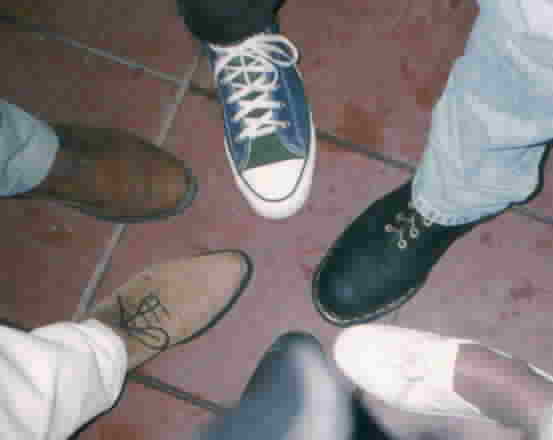
Three out of four women said their fellow has
an old pair of shoes he should throw out, but won't. --A Johnson &
Murphy footwear poll of U.S. women aged 25 to 44 (Bonino
1994:B1)
Everyone has a shoe fetish. --Sonja Bata, founder of the
Bata Shoe Museum in Toronto (Trueheart 1995:C10)
Clothing
cue. A masculine style of footwear marked with messaging
features designed to contrast with those of women's
shoes (see CONSUMER
PRODUCT).
Usage: In expressive style, men's leather shoes are a. dominant, b. submissive, or c. neutral.
Stomping I. Dominant shoes are typified a. by thick, crepe-soled "beetle crushers" worn by English Teddy boys of the 1950s; b. by middle-class Desert Boots of the 1950s and 1960s; c. by urbane Timberland boots of the 1970s; and d. by aggressive Doc Marten boots worn by alienated young men and women of the 1990s. Dominant styles are robust--wide, thick, and heavy--to accent the size of the foot and its ability to stomp (see GOOSE-STEP).
Stomping II. The oldest stomping shoes are sandals from ancient Egypt with pictures of enemies painted on the soles. More recently, by popularizing thick, buckled motorcycle boots in the media, Marlon Brando (The Wild One, 1954) and Peter Fonda (Easy Rider, 1969) furthered the role of footwear as a fashion statement (i.e., with which to figuratively "stomp" the powers-that-be).
Mincing. Men's submissive shoes are narrow, with lightweight uppers, thin soles, and tapering toes. Styles include a. pointed "winkle-pickers" worn by British Mods of the 1950s; b. pointed-toed Beatle boots of the 1960s; and c. Gucci loafers, the late-20th century's premier power slipper. Submissive styles are gracile to suggest vulnerability, and to downplay the foot's size and bluntness. Moreover, they stand wearers precariously on their metatarsal bones in a tip-toed position. Unstable, high-heeled styles (e.g., the Beatle boot) make it harder for wearers to stomp.
Hushing. The third prototype in men's footwear is the neutral shoe,
which is neither dominant nor submissive, but fashionably bland and introverted.
It is neither wide nor narrow, neither pointed nor blunt; the sole is neither
thick nor thin, nor is the shoe obviously masculine or feminine. The neutral shoe is personified by dark-gray, brushed-pigskin Hush Puppies (1950s-to-1990s
[see below, Media]), and by Ivy League saddle shoes and penny loafers
(1950s-to-1990s), worn by men and women alike.
Media. "When those technicolor
[e.g., bubble gum pink, lemon yellow] Hush Puppies appeared on the New York
runway, fashion wags went berserk. The shoes began appearing in GQ magazine.
Stylists snapped them up to dress musicians for videos. They were used to
accessorize pricey clothes with puffed-up designer labels. Forrest Gump wore
them. Fashion insiders began publicly proclaiming their love for Hush Puppies"
(Givhan 1995:C2).
Observation. Neutral shoes are a successful family of footwear,
specialized neither for stomping, mincing, or showing attitude--but for comfort.
The casual, low-profile, laid-back style makes neutral shoes unsuitable for
fast-track careers, but convenient for projecting a non-rebellious,
non-dominant, anti-corporate mood on campus or in the workplace.
See also
BOOT.
Copyright 1999 - 2016 (David B. Givens/Center for Nonverbal Studies)
"Circle of Friends and Footwear" (San Diego, California, USA; photo credit: David B. Givens [copyright 2000])